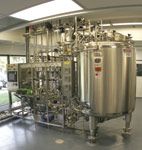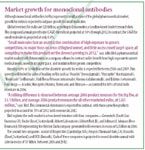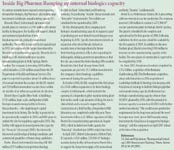CMOs Expand Biologics Manufacturing
A surge in capacity in contract microbial and mammalian cell-culture is underway to meet rising production needs for biopharmaceuticals.
Continuing growth in biopharmaceutical product revenues and pipeline candidates bodes well for the contract biologics market. Worldwide revenues for biopharmaceutical products is estimated to exceed $65 billion in 2007, and the proportion of pharmaceutical revenues from biotechnology drugs is estimated to surpass 10% of the total market (1).

Patricia Van Arnum
Growth in contract manufacturing
Global spending on biopharmaceutical contract production was estimated at $2.1 billion in 2006, according to a recent study by HighTech Business Decisions (San Jose, CA) (1). This level is expected to rise to $2.8 billion in 2008 and $4.3 billion by 2009.
On a supply level, between 2004 and 2008, worldwide contract manufacturing capacity for biopharmaceuticals is expected to grow by approximately 40% (1). Measuring capacity in tank liters under the two broad categories of microbial fermentation and mammalian cell culture, the study shows that biopharmaceutical contract manufacturers' installed capacity for microbial fermentation will reach 300,000 tank liters by 2008, an increase of 15% from two years ago. Biopharmaceutical contract manufacturers also plan additional follow-on capacity expansions throughout the next five years. (This estimate includes capacity for biopharmaceutical production only; microbial capacity that is used for microbially produced small molecules or products such as antibiotics is not included.)

A 2500-L mammalian cell culture bioreactor in one of Laureate Pharma's manufacturing suites. Photo: Laureate PHARMA
Worldwide outsourced mammalian cell-culture capacity is expected to reach 670,000 tank liters by 2008, a 21% increase from two years ago, according to HighTech Business Decisions (1). As with microbial-fermentation capacity, biopharmaceutical contract manufacturers plan follow-on capacity expansions during the next five years.

Market growth for monoclonal antibodies
Capacity utilization. Biopharmaceutical contract manufacturers report average utilization rates of 72-87% for microbial fermentation production capacity. Average capacity utilization rates for mammalian cell-culture production vary from 65% to more than 90%. In both instances, capacity utilization rates are expected to increase during the next two years and then drop slightly as current and planned capacity expansions come on line (1).

Inside Big Pharma: Ramping up internal biologics capacity
Investments by top players
Several top CMOs are expanding capacity. Based on revenues, the top biopharmaceutical CMOs include Avecia Biologics (Billingham, United Kingdom), Boehringer Ingelheim (Ingelheim, Germany), Diosynth Biotechnology (Morrisville, NC), Lonza (Basel, Switzerland), and Sandoz (Holzkirchen, Germany), according to HighTech Business Decisions.
Lonza. Reflecting strong growth in its biopharmaceutical business, Lonza is investing in microbial and mammalian cell-culture production. Following its $460-million acquisition of Cambrex's (East Rutherford, NJ) bioproducts and biopharmaceutical business in February, Lonza named Hopkinton, Massachusetts, as the global US headquarters for its microbial biopharmaceutical business and announced plans to invest more than $30 million in its Hopkinton site to support growth plans for microbial process development and manufacturing. The Cambrex acquisition gave Lonza additional biopharmaceutical services capabilities and small-and mid-scale microbial manufacturing capacity to complement existing microbial capacity in Visp, Switzerland. Lonza started producing current good manufacturing practices (CGMP) batches at a new 15,000-L microbial biopharmaceutical line in Visp earlier this year, and a second line is now operational.
Earlier this year, Lonza began construction of its second large-scale mammalian facility in Singapore. The final build-out of the facility is expected to be completed and operational in 2011. The $350-million facility will have four mammalian bioreactor trains, each with a flexible capacity of 1000–20,000 L, inclusive of purification units.
In May 2007, Lonza broke ground for a new $300-million, 330,000-ft2 -facility for biopharmaceutical manufacturing technologies, support systems, and warehouses in Portsmouth, New Hampshire, where the company has commissioned its largest-scale mammalian cell-culture plant to date. Lonza also is adding a 5000-L bioreactor to the existing facility, which has 93,000 L of capacity.
The expansions at Portsmouth follow Lonza's acquisition of Genentech's (South San Francisco, CA) mid-scale mammalian biopharmaceutical production plant in Porriño, Spain, in late 2006.
Lonza further added to its biopharmaceutical toolbox with the acquisition of the "AggreSolve" technology and service business of Zyentia (Cambridge, UK). AggreSolve is an in silico protein-analysis platform that can be applied to solving the problems posed by protein aggregation. Lonza made the acquisition in August 2007.
Boehringer-Ingelheim. Boehringer-Inghelheim modernized and expanded high-yield fermentation processes for mammalian cell cultures at its biopharmaceutical production facility in Biberach, Germany. The project, which was first announced in 2005, was scheduled for completion this fall.
Avecia Biologics. In May 2007, Avecia Biologics (Billingham, United Kingdom) launched a new biotherapeutic protein production technology, "pAVEway." The technology enables microbial production (> 10 g/L) for therapeutic proteins such as vaccines, cytokines, and growth factors. In October, the company reported that it was investing £1 million ($2.1 million) to add a suite of biologics laboratories at its facilities in Tees Valley, United Kingdom to add 20% more research and development work based on the pAVEway platform.
Diosynth. Diosynth, the third-party manufacturing unit of Organon BioSciences (Oss, Netherlands), will be undergoing a change of ownership pending Schering-Plough's (Kenilworth, NJ) $14.4-billion acquisition of Organon BioSciences from Akzo Nobel (Arnhem, The Netherlands). Schering-Plough is acquiring Organon in part to expand its position in biologics. Organon BioSciences consists of Organon (human pharmaceuticals), Intervet (animal health), Nobilon (human vaccines ), and Diosynth. Schering-Plough received approval from the European Commission for the deal in October and hopes to complete the acquisition, which includes receiving US regulatory approval, by the end of 2007.
Other CMO expansions
Other CMOs are expanding. Wacker (Munich, Germany), which provides contract microbial manufacturing, is investing EUR 15 million ($22 million) at its biopharmaceutical operations in Jena, Germany. The first project doubles its manufacturing space by adding a new purification station to help ease bottlenecks. The station will operate under good manufacturing practices. The facility is scheduled to come on steam in 2009.
In the second project, Wacker is constructing a new building in Jena for process development and quality control. The building is scheduled for completion in late 2008 and will support the company's proprietary E. coli-based protein secretion technology.
SAFC (St. Louis, MO) plans to invest $29 million to expand its drug-substance capabilities in high-potency biologics at the Sigma-Aldrich facility in Jerusalem, Israel. The 50,000-ft2 high-potency fermentation expansion is scheduled for completion in the first quarter of 2009.
Laureate Pharma (Princeton, NJ) opened a new pilot plant for preclinical biopharmaceutical manufacturing in March. The plant is designed for process development, production, and purification of early-phase preclinical proteins
Startups for analytical services
The growth is biopharmaceuticals is also broadening applications in contract analytical services. Last month, NanoImaging Services (San Diego, CA) began offering high-resolution, three-dimensional transmission electron microscopy (TEM) imaging services to manufacturers of large-molecule biopharmaceuticals. "Although this technology is well-proven in the laboratory, we are the first to offer it as a commercial service," said Bridget Carragher, NanoImaging's chief operating officer in a company release.
Carragher and CEO Clinton Potter, associate professors at The Scripps Research Institute in San Diego, founded NanoImaging Services with support from FEI Company (Hillsboro, OR), a manufacturer of TEMs and other nanotechnology tools.
TEM can be applied to various samples, which include proteins, protein complexes, viruses, virus-like particles, biological vaccines, lipid vesicles, and cell-free lysates.
The company worked on the characterization project for "Gardasil," Merck & Co.'s (Whitehouse Station, NJ) vaccine against certain types of the human papillomavirus Using cyro TEM, Potter and Carragher developed advances in specimen preparation, microscope control and automation, and data tracking.
NanoImaging offers services from visual inspection and statistical characterization to three-dimensional reconstruction and antibody/labeling experiments, using TEM procedures that range from conventional negative staining to advanced cryo techniques with automated image acquisition and analysis, according to company information. In the most advanced applications, samples in physiologic solution are instantly frozen in vitreous ice to preserve biological structures in their native hydrated state. Thousands of images, automatically acquired with low-dose techniques, are sorted and averaged together to create high-contrast, high-resolution (approaching 1 nm), low-noise images, and statistically valid sampling. A secure web-based interface allows images to be viewed remotely and direct experiments remotely, in real time. Results, along with all meta data, are stored in a relational database.
Patricia Van Arnum is a senior editor at Pharmaceutical Technology, 485 Route One South, Bldg F, First Floor, Iselin, NJ, 08830, tel. 732.346.3072, pvanarnum@advanstar.com
References
1. W. Downey and L. Sopchak, "Evaluating Supply and Demand Patterns for Contract Biologics Manufacturing," Pharm. Technol. 31 "Outsourcing Resources Suppl.," 24–32 (2007).

Pharmaceutical Tariffs Are Imminent: How Industry is Bracing for Impact
April 16th 2025On April 14, 2025, the Trump Administration launched a national security-driven investigation into pharmaceuticals, a move that will likely result in tariffs being placed on pharmaceutical drugs, ingredients, and other components that are imported from outside of the United States.
Drug Solutions Podcast: A Closer Look at mRNA in Oncology and Vaccines
April 30th 2024In this episode fo the Drug Solutions Podcast, etherna’s vice-president of Technology and Innovation, Stefaan De Koker, discusses the merits and challenges of using mRNA as the foundation for therapeutics in oncology as well as for vaccines.